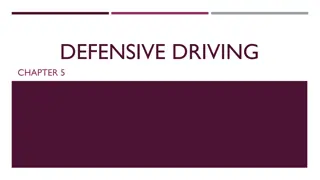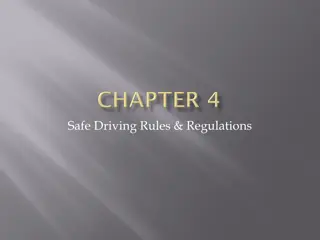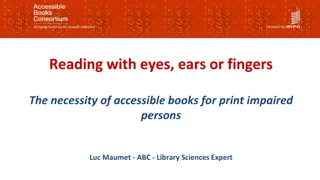Effectiveness of Lower BAC Limits in Reducing Impaired Driving
Lowering the BAC limit for driving to .05 has been shown to reduce impaired driving incidents significantly. Virtually everyone is impaired at .05 BAC, leading to a marked increase in crash risk. While most states adhere to the .08 BAC limit, some like Utah have already adopted the .05 limit. Even though progress was initially made in reducing impaired driving fatalities, the percentage of fatally injured drivers with impairing alcohol levels has plateaued since 1997. Studies consistently show the negative impact of increasing BAC levels on driving performance.
Download Presentation

Please find below an Image/Link to download the presentation.
The content on the website is provided AS IS for your information and personal use only. It may not be sold, licensed, or shared on other websites without obtaining consent from the author. Download presentation by click this link. If you encounter any issues during the download, it is possible that the publisher has removed the file from their server.
E N D
Presentation Transcript
.05 BAC Limits: Evidence of the Effectiveness in Reducing Impaired Driving James C. Fell NORC at the University of Chicago Bethesda, MD Office VISION ZERO RESEARCH ON THE ROAD New York City, NY November 16, 2022
BAC Per Se Limits in the United States All States, DC and PR have had .08 per se BAC laws since 2005. Minnesota was the last state to adopt .08 (8/1/05) With a per se BAC statute, only the validity of the BAC measurement itself is at issue. Only Utah has enacted a .05 BAC limit thus far. All other states use .08 g/dL. NY, WA and HI have recently introduced .05 BAC legislation [Source: Alcohol Policy Information System, NIAAA]
Rationale for a .05 BAC Limit for Driving in the US Virtually everyone is impaired at .05 BAC. It is a level at which critical driving skills are impaired. .05 BAC is a level at and above which the risk of a crash is increased significantly. .05 BAC is a level which most industrialized countries have adopted. Is an effective measure which has been shown to reduce alcohol-related fatalities.
Progress in Reducing Impaired Driving in the US Substantial progress in reducing impaired driving fatal crashes was made between 1982 and 1997. Many DWI laws were passed in the states and impaired driving enforcement was increased. However, since 1997 the percent of fatally injured drivers who were impaired has stalled.
Proportion of All Fatally Injured Drivers Estimated to Have Impairing Alcohol (BAC .05), 1982-2019 [-35%]
National Survey of Drinking & Driving Q31: How many [drinks of alcoholic beverages drunk most often] could you drink in two hours before you should not drive? [Base: drivers who drink**] [Source: Royal 2003]
Experimental Studies of Impairment and BAC Percent Decrement in Performance Measure 70 60 50 40 30 Moskowitz (1985) 20 Moskowitz (1974) Mortimer (1963) 10 Landauer (1983) Laurell (1975) 0 0 .01 .02 .03 .04 .05 .06 .07 .08 .09 BAC
Relative Risk* of Being Involved in a Fatal Crash by BAC BAC .08 - .099 12.61 Driver Age 16-20 .05 - .079 6.24 >.15 490.41 21-34 8.74 200.03 4.78 35+ 6.89 111.94 4.03 *Risk relative to BAC=.00 for same age group Study used data from the 2007 FARS cases and the 2007 National Roadside Survey control data to calculate relative risks at various BAC levels [Source: Voas, Torres, Romano, Lacey, JSAD, (2012)]
Studies of the Effects of Lowering the Illegal BAC Limit to .05 Percent drivers with positive BACs in weekend fatal crashes decreased 13% pre- post law implementation but did not affect weekday fatal crashes Lowering the BAC limit to .05 resulted in an 11% decrease in alcohol-related fatal crashes and significant reductions in the number of non-fatal crashes Resulted in 38% decrease in alcohol-related crashes of all severities 10% reduction in alcohol-related fatal crashes and significant reductions in single vehicle crashes and all crashes associated with lowering limit to .05 Australia (Homel, 1994) Australia (Henstridge et al., 1997) Japan (Nagata, et al., 2008) Sweden (Norstrom, 1997)
Illegal Per Se BAC Limits for Driving Country BAC Limit .05 .05 .05 .05 .05 .05 .05 .05 .05 Australia Austria Belgium Denmark Finland France Germany Italy Spain [Source: WHO 2012]
Objective of Recent Study Funded by NIAAA (Fell & Scherer, 2017) Determine whether lowering the BAC limit from .08 g/dL to .05 g/dL will be an effective policy in the United States using meta- analyses.
Methods Conduct a meta-analysis of qualifying international studies to estimate the range and distribution of the most likely effect size from a reduction in BAC to .05. Translate the synthesis toward estimating the effects of reducing the current .08 BAC limit to .05 BAC in the U.S. Estimate the life-saving benefits of the proposed reduction in the BAC limit from .08 to .05 (a .03 reduction in BAC)
6 Studies of the Effects of Lowering the BAC Limit on Alcohol Consumption Forest plot of articles examining alcohol consumption related outcomes
9 Studies of the Change in Non-Fatal Alcohol- Related Crash Rate After Lowering BAC to .08 Forest plot of articles examining non-fatal alcohol-related crash outcomes
14 Studies of the Change in Alcohol-Related Fatal Crashes After Lowering BAC to .08 Forest plot of articles examining alcohol-related fatal crash outcomes associated with lowering BAC limit to .08
11 Studies of the Change in Alcohol-Related Fatal Crash Rates After Lowering the BAC to .05 or lower Forest plot of articles examining alcohol-related fatal crash outcomes associated with lowering BAC limit to .05 or lower
Conclusions Lowering the BAC limit to .05 (or lower) resulted in a significant 11.1% decline in fatal alcohol- related crashes according to the meta-analysis.
Conclusions It is estimated that 1790 lives could be saved each year if all states lowered the BAC limit to .05 in the U.S.
Evaluation of Utahs .05 Per Se Law The fatal crash rate reduction from 2016 to 2019 in Utah was 19.8%. In comparison, the rest of the United States showed a 5.6% fatal crash rate reduction from 2016-2019. No significant change in DUI arrests and alcohol sales and tourism measures continued to increase. The report concluded: Overall, ...05 per se law had demonstrably positive impacts on highway safety in Utah.
Implications for .05 BAC Progress in reducing impaired drivers in fatal crashes has stalled since 1997 and has now increased in 2020 and 2021. It will be at least 10 years before technological solutions can be implemented (e.g. DADSS, autonomous cars) 10,000 deaths each year due to impaired driving is unacceptable. A .05 BAC limit is a countermeasure that is proven to saves lives.
Contact Information: James C. Fell Principal Research Scientist National Opinion Research Center (NORC) at the University of Chicago Bethesda, MD 20814 301-634-9576 (office) 240-354-2137 (cell) E-mail: fell-jim@norc.org























